Post by TasunkaWitko on Apr 1, 2013 15:55:50 GMT -5
Recently, I made porchetta for the first time - it wasn't perfect, but it turned out very well, and certainly won't be the last time I make it!
Not long before this project, I had made a Caribbean pernil. I had good success with that project, and I had been wanting to try a porchetta for quite a while, so I figured, why not? The actual cooking methods were similar, even if the ingredients were different. I just happened to have an 8.5-pound pork shoulder roast in the freezer ~ perfect for something like this, with a nice fat cap for self-basting, and a beautiful layer of skin on the surface, which would roast up in crispy-wonderul mahogany fashion (or so I hoped).
After consulting recipes and procedures for porchetta here:
foodsoftheworld.activeboards.net/porchetta_topic1430.html
and here:
foodsoftheworld.activeboards.net/ariccia-lazio-porchetta-roast_topic2646.html
I decided to try what I hoped was a good average of knowledge that I had available and what I could do with it.
Two ingredients that are quintessential to porchetta are rosemary and fennel; for this project, I decided to use these two ingredients in fresh form, so I cut the fronds off some fresh fennel, and gathered some rosemary:
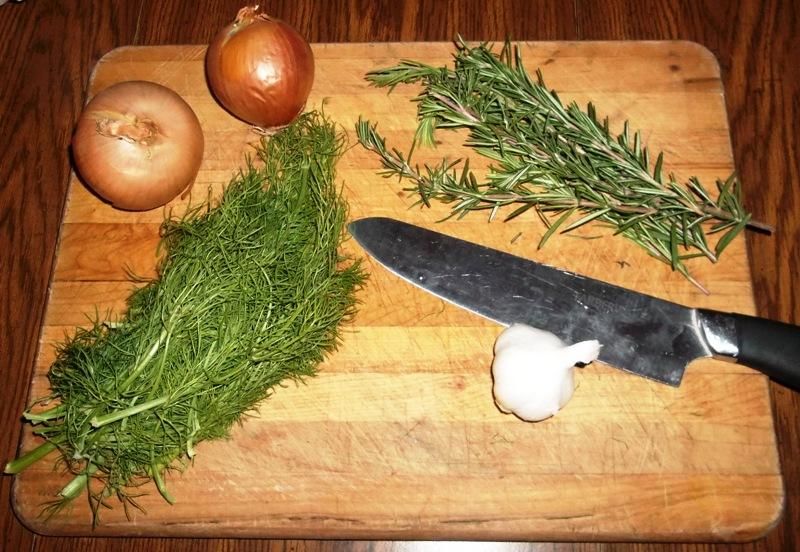
As you can see, I also employed two onions and some fresh garlic.
I spent the next few moments preparing the fennel fronds and rosemary:
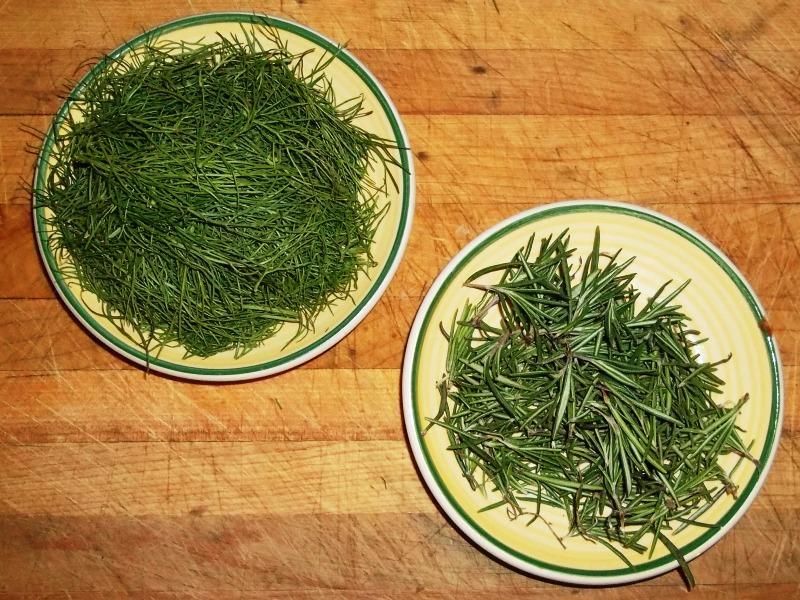
Next, I chopped the onions fairly fine, and then peeled the head of garlic and gave the cloves a rough chop:
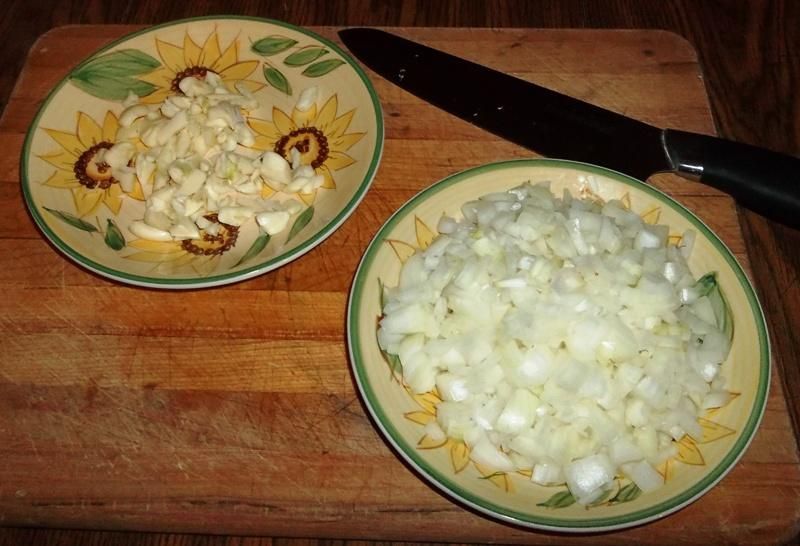
Next, in a mortar and pestle, I pulverised the garlic with 2 tablespoons of kosher salt:

After that, I measured out 2 tablespoons of peppercorns and a generous tablespoon of fennel seeds:
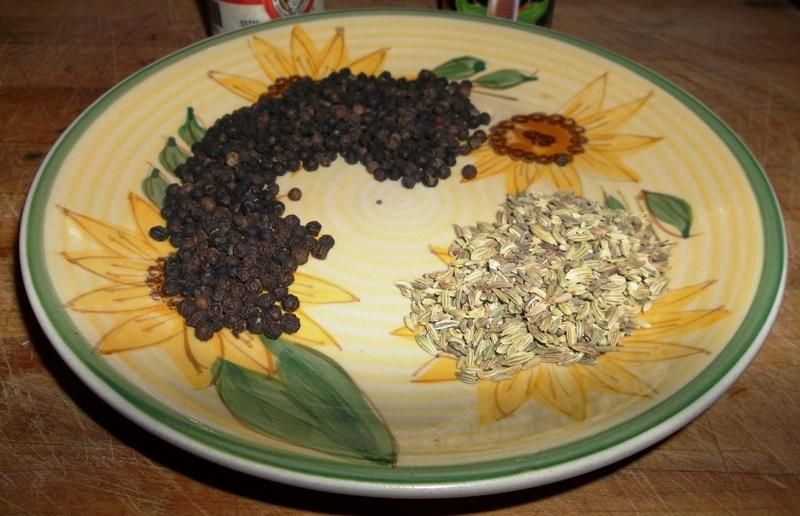
I then ground them up in the mortar and pestle:
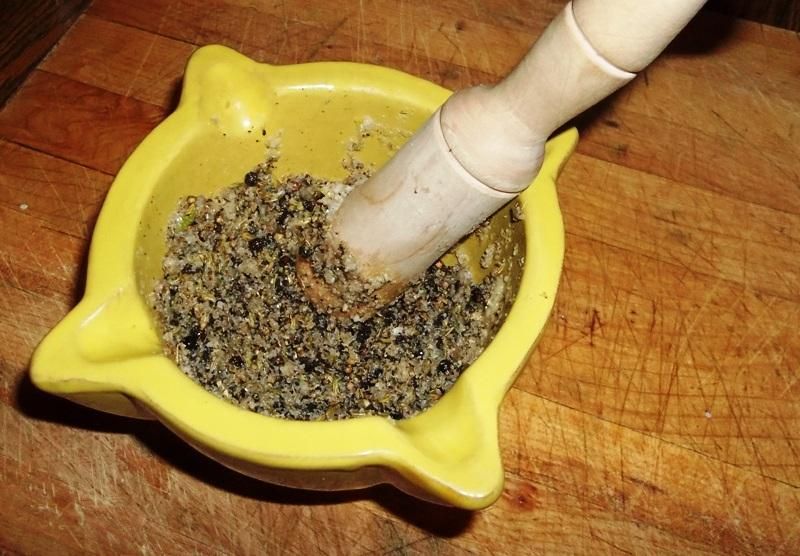
Next, I measured a tablesppon of dried oregano and a generous teaspoon of dried thyme:
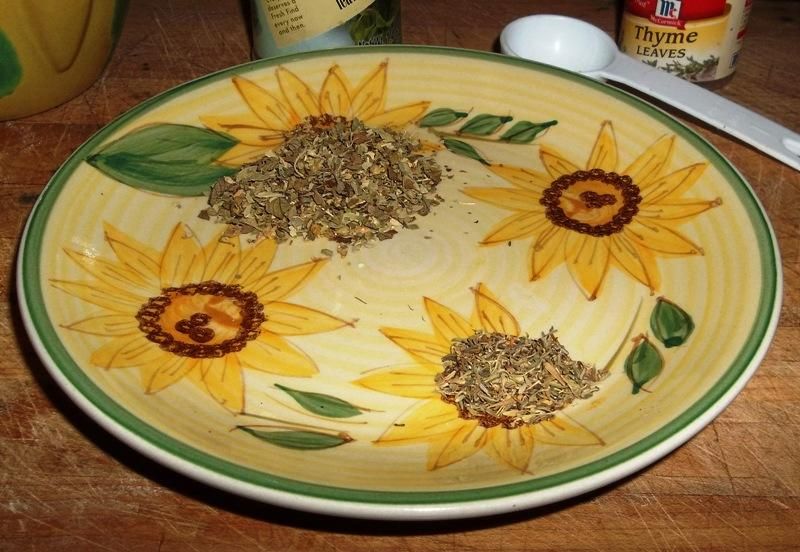
I then added them to the mix along with 2 tablespoons of olive oil:

I then added the juice of one whole lemon:
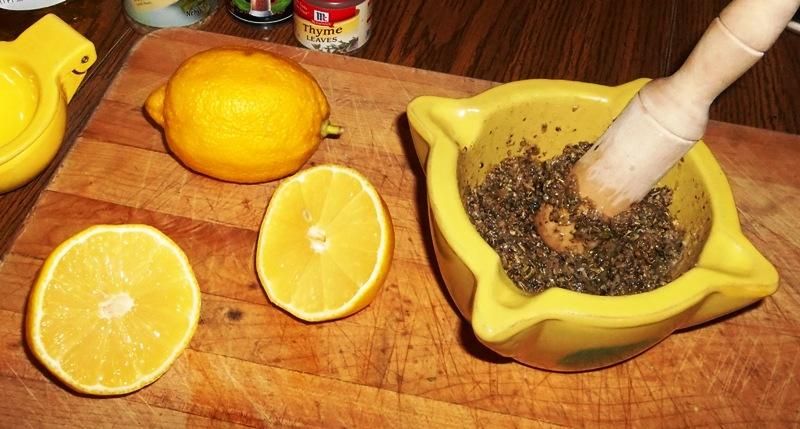
Looking back, it was probably a mistake to add this much lemon; two tablespoons might have been adequate, but then again, I am not sure. More study and experience in this area is definitely warranted, but it seemed like too much liquid to me.
Next, I added the rosemary leaves:

I worked them into the mixture well, crushing them thoroughly with the mortar and pestle in order to release all the great things that rosemary has to offer. I then considered my fennel fronds:

It seemed like things were getting a little crowded, so I transferred everything to a larger bowl, and then added the fennel fronds. Once they were incorporated well, I also added the finely-chopped onion. I mixed this all together into what I will call a marinata bagnata; it resembled some sort of green, chunky onion salsa:
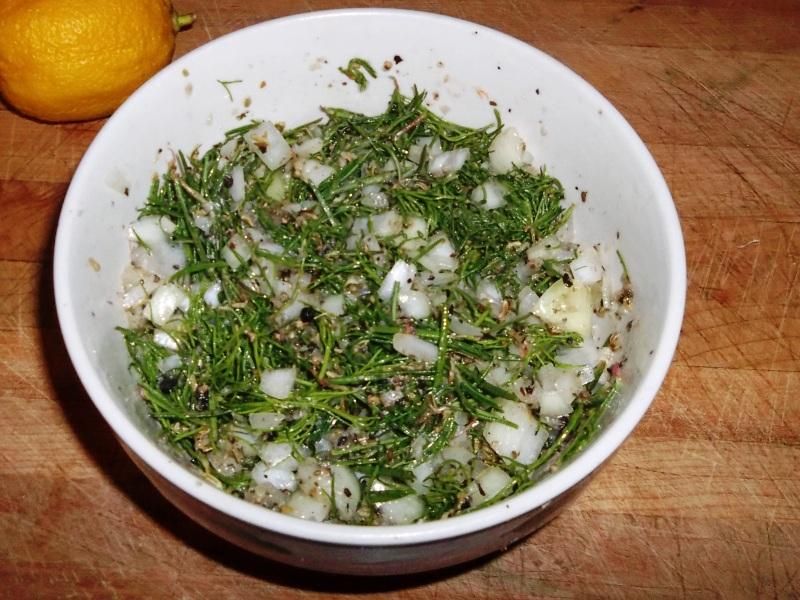
I then set it aside and turned my attention to the pork roast.
First, I scored the skin of the roast with diagonal slashes:
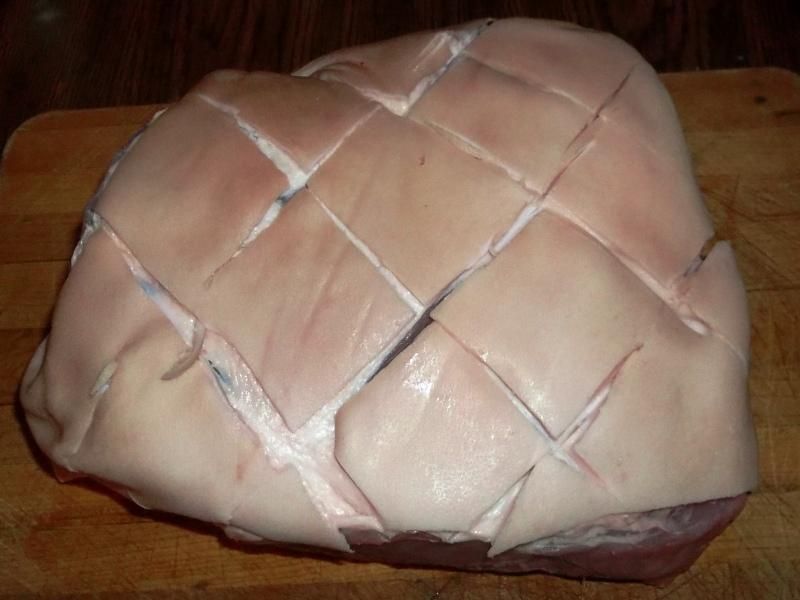
After that, I flipped the roast over and carefully cut down along the long bone:
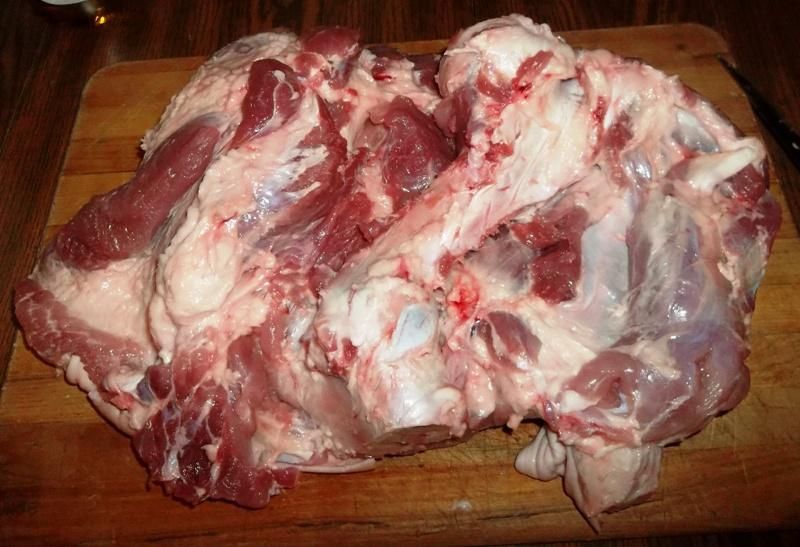
This was a first for me, at least with this type of roast. I've done it while butchering countless deer, and while that experience helped, it was definitely a new new ball game with a pork picnic soulder, but it wasn't too long before I had worked my way around the bone, which I then removed:
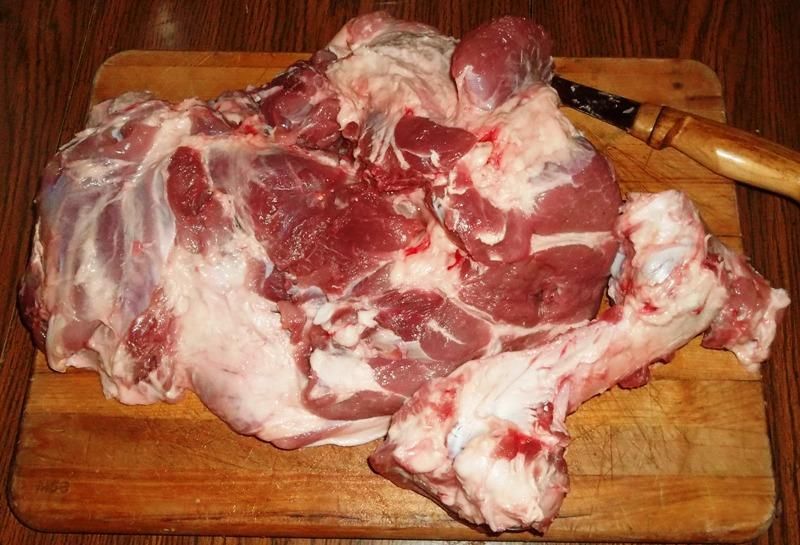
I then continued cutting through until I butterflied the roast:

In some areas, the roast was thicker than others, so I took the time to open those areas up as well, in preparation for my next step.
Once the roast was butterflied, I then spread the marinata bagnata - which is Italian for adobo mojado (according to Google Translate, at least) - over the exposed pork:

And then I watched as most of the lemon juice promptly ran right out of the roast and onto the table. Okay, less lemon juice next time, I guess!
I then rolled the roast back together, not quite as tightly as I would have preferred, but probably tight enough:

I then made a complete mockery out of the art of tying the roast:
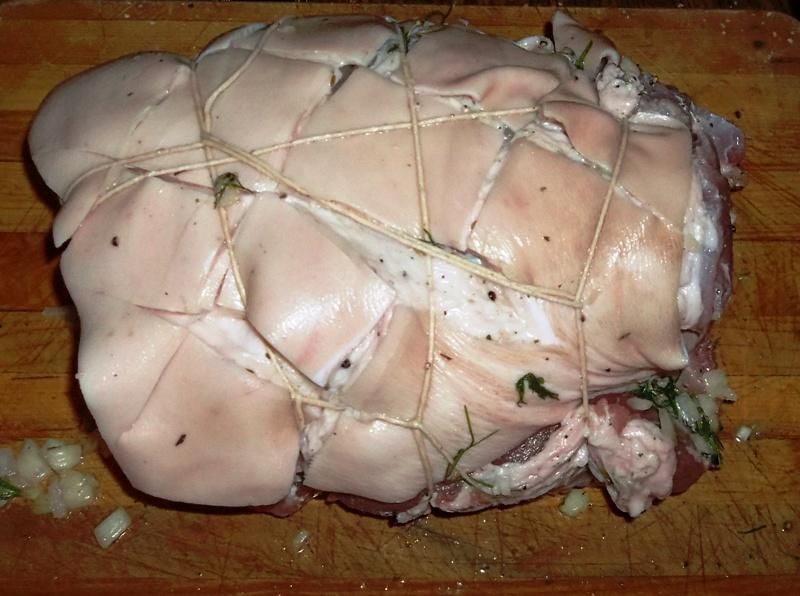
Once this was done, I placed it in my enameled cast-iron Dutch oven - skin-side-up:

I then sprinkles a pinch or two of kosher salt over it, covered it with the lid, and set it in the refrigerator to marinate overnight so that the flavours could get to know each other.
The next day, I followed a procedure similar to the one I used when making Cuban pernil, roasting the porchetta it in two stages. To begin, I roasted it for about 2.5 hours, covered, while it slowly began to fill the house with a fresh, savory aroma that rerally and truly reminded me of spring.
At this time, at least when making pernil, a braising liquid is added, and the roast is cooked un-covered for the duration in order to develop some colour and character. For this project, I chose a pretty nice pinot grigio from Barefoot vinyards:

This label has always done pretty well for me, and this project was no exception; I added 1.5 cups of white wine as a braising liquid:
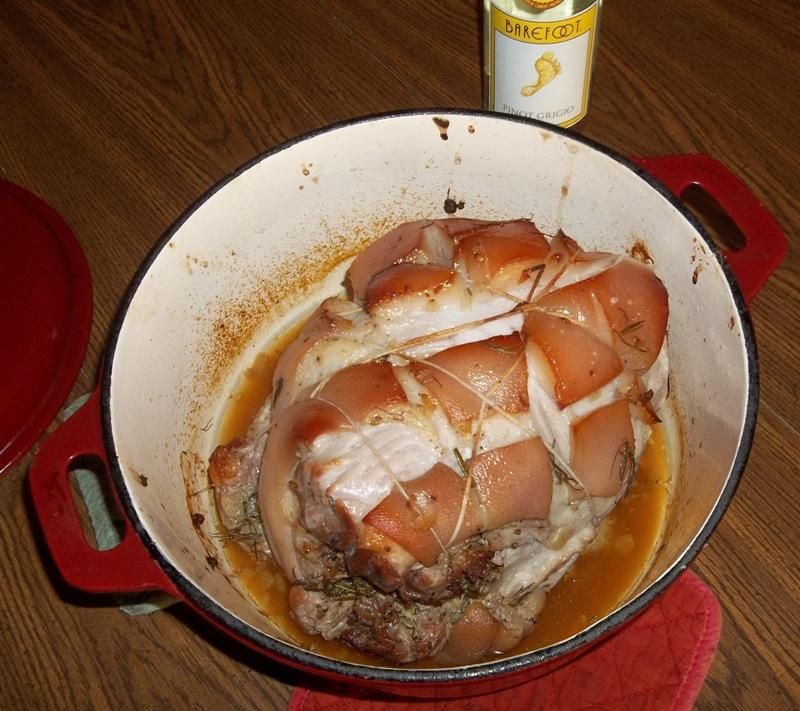
And then I returned the pork to the oven, uncovered, for another couple of hours, until it was fork-tender and seemed juicy as could be. During this time, the aromas really went into overdrive, with the herbs and spices working with the wine and lemon juice to provide a truly Italian atmosphere.
The pork seemed done to a point where it was nearly perfect, but the skin didn't seem quite as beautiful and crispy as I thought it should be:
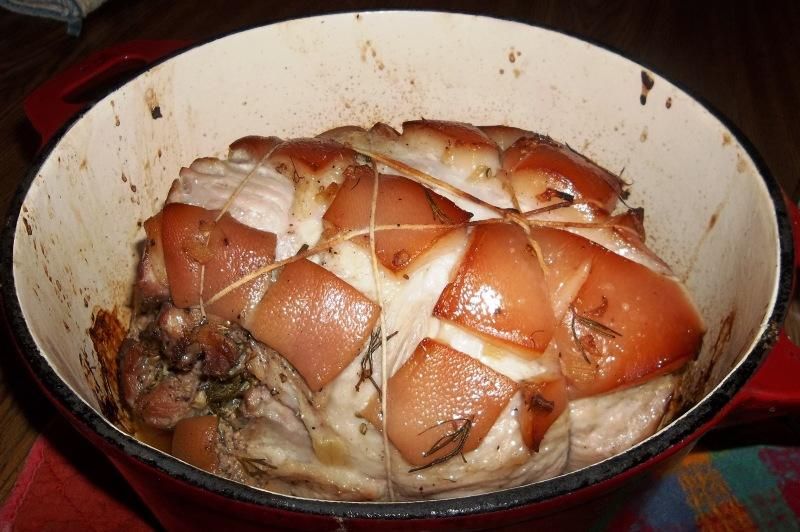
So I put it under the broiler for about 10 minutes. This might have been a couple of minutes too long, as you can see:
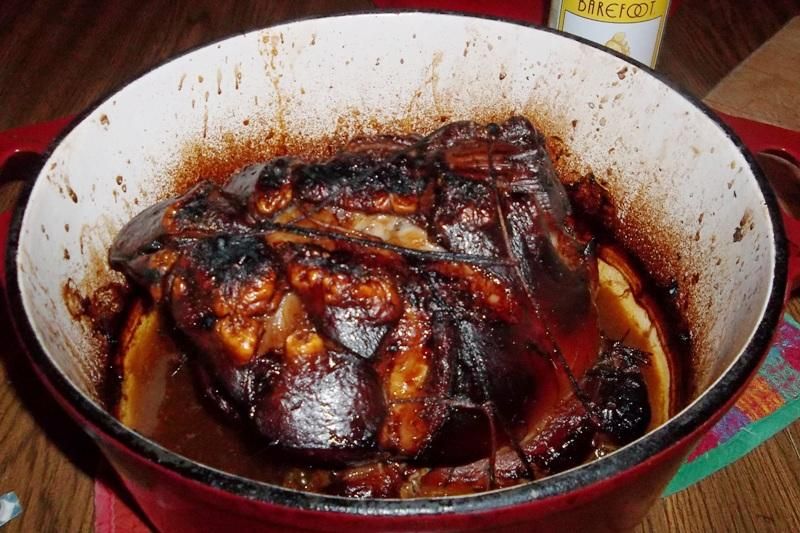
But then again, perhaps it was just right!
I took the roast out to rest for perhpas 15 minutes as I de-fatted the pan juices and deglased the Dutch oven with some more wine; I then cooked the resulting sauce down a bit for serving, adding the de-fatted drippings for an extra kick of savoriness. I then cut tor roast open and shredded it with two forks, chopping the skin up separately, and served the porchetta with mashed potatoes on the side:
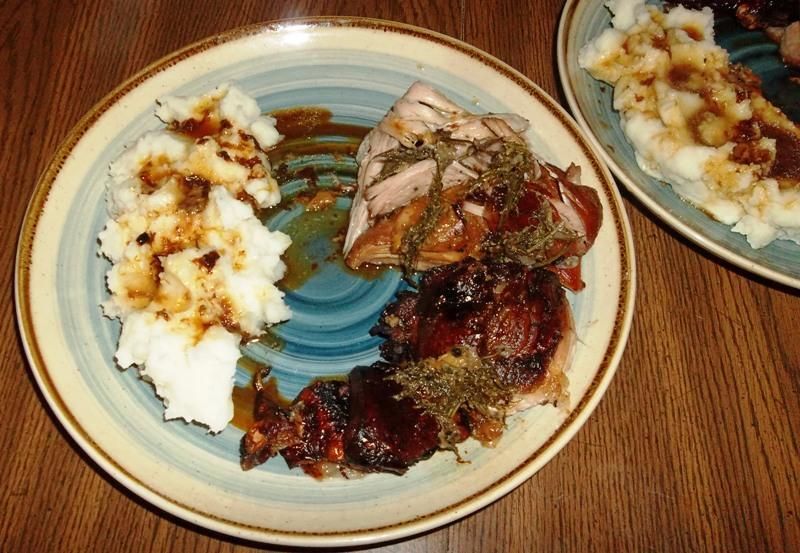
The onions had pretty much melted away into the sauce, but the rosemary and fennel fronds remained. I didn't know what to do with them, so I served them with the pork, which the Beautiful Mrs. Tas did not like at all; next time, I will strain the sauce! Also, I'd intended to make an orange-fennel salad from the bulb, to serve with the meal, but forgot about it in the rush of making mashed potatoes and cutting and serving the roast as everyone was clamoring for supper.
All-in-all, in spite of the sloppy work, this turned out really well, and I was very impressed with the flavours of this dish, which I had been wanting to make for quite a long time. While I was preparing it, I had been worried about the terrible tying job that I had done, and a possible excess of lemon juice; in addition, I was worried at first that I had used to much salt. As it turned out, most of the things I worried about didn't matter too much. The tied roast held together just fine while cooking, the salt level was just about perfect and over-all, I'd call this a success.
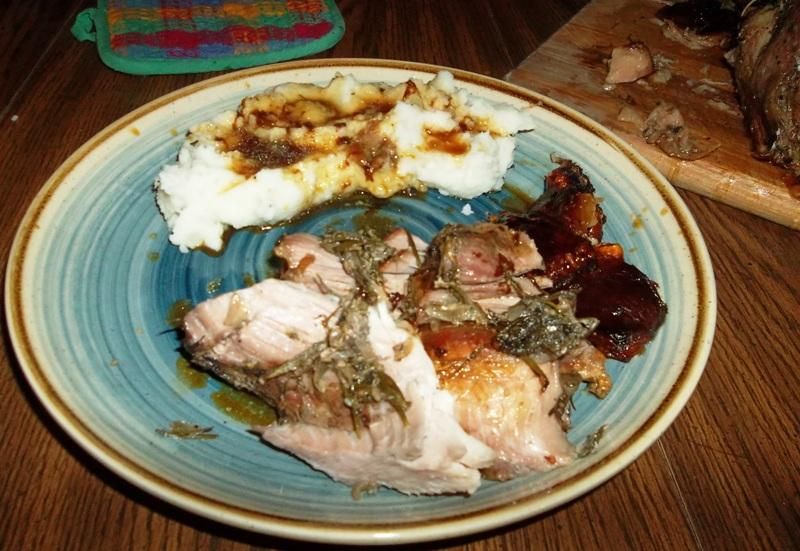
The only real problem was that I didn't get the mohogany-crisp skin that I had seen on the pernil projects I had been making recently with a similar cooking procedure; then again, even though it got a tad dark; it tasted great, and that's the thing that matters. In spite of the skin troubles, the roast itself was cooked very well, with all the fat rendering out for a very tender end product that was literally falling apart when I untied it - a perfect, juicy "pulled pork" texture that was not mushy. Dark skin notwithstanding, I couldn't have asked for a better-cooked roast.
The flavour combinations in the fennel, rosemary, thyme, onion, garlic, oregano and other flavours really worked great together, and had the whole house smelling like a house should smell when delicious meat is roasting. The herbs were assertive and made their presence known, while working well with the roasted pork. The over-all profile seemed bright and brought forth impressions of spring, which, at the time, was just around the corner. The pinot grigio worked very well as a braising and de-glazing liquid, and it was definitely a great choice for this dish.
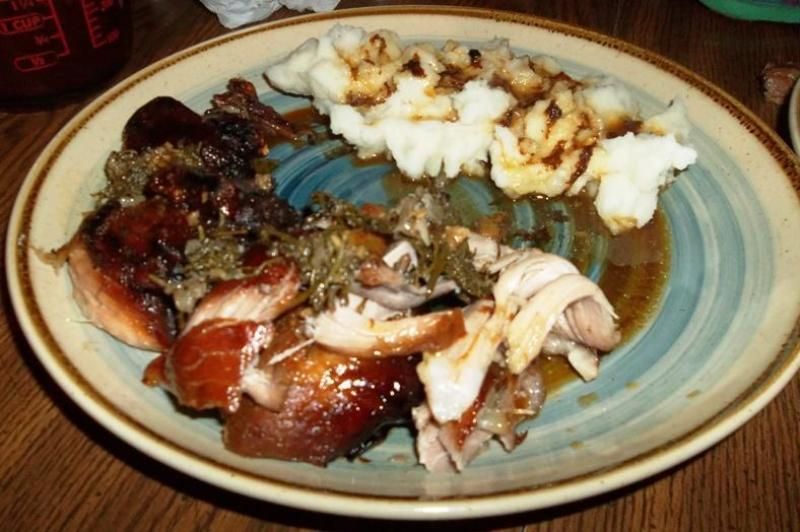
I'd like to make this again, and probably will in some slightly modified form; as I said before, the Beautiful Mrs. Tas, who really liked the pernil, wasn't a fan of this - she doesn't really like "herby" dishes to begin with, and the fresh rosemary and fennel fronds were just "grass in the meat" as far as she was concerned. With this in mind, I'll definitely strain the liquids next time, as I said before.
To review, here's the "recipe" that I came up with for an 8.5-pound porchetta:
12 cloves (one large bulb) garlic
2 tablespoons Kosher salt
2 tablespoons peppercorns
1 generous tablespoon fennel seeds
1 tablespoon dried oregano
1 generous teaspoon dried thyme
Add this to the mix above:
2 tablespoons extra virgin olive oil
Juice of 1 lemon (2 tablespoons might be better)
3/4 ounce (maybe 6 or 7 sprigs' worth) fresh roasemary leaves
The stripped fronds from 1 bulb of fennel
2 small onions (equivalent to a large onion), finely chopped
Thanks for looking at my meal, and if you'd like to give it a try, please feel free to ask any questions you might have. Since this was my first porchetta, and and all feedback would be greatly appreciated; this tasted very good, but I am sure that there is room for improvement as always.
Not long before this project, I had made a Caribbean pernil. I had good success with that project, and I had been wanting to try a porchetta for quite a while, so I figured, why not? The actual cooking methods were similar, even if the ingredients were different. I just happened to have an 8.5-pound pork shoulder roast in the freezer ~ perfect for something like this, with a nice fat cap for self-basting, and a beautiful layer of skin on the surface, which would roast up in crispy-wonderul mahogany fashion (or so I hoped).
After consulting recipes and procedures for porchetta here:
foodsoftheworld.activeboards.net/porchetta_topic1430.html
and here:
foodsoftheworld.activeboards.net/ariccia-lazio-porchetta-roast_topic2646.html
I decided to try what I hoped was a good average of knowledge that I had available and what I could do with it.
Two ingredients that are quintessential to porchetta are rosemary and fennel; for this project, I decided to use these two ingredients in fresh form, so I cut the fronds off some fresh fennel, and gathered some rosemary:

As you can see, I also employed two onions and some fresh garlic.
I spent the next few moments preparing the fennel fronds and rosemary:

Next, I chopped the onions fairly fine, and then peeled the head of garlic and gave the cloves a rough chop:

Next, in a mortar and pestle, I pulverised the garlic with 2 tablespoons of kosher salt:

After that, I measured out 2 tablespoons of peppercorns and a generous tablespoon of fennel seeds:

I then ground them up in the mortar and pestle:

Next, I measured a tablesppon of dried oregano and a generous teaspoon of dried thyme:

I then added them to the mix along with 2 tablespoons of olive oil:

I then added the juice of one whole lemon:

Looking back, it was probably a mistake to add this much lemon; two tablespoons might have been adequate, but then again, I am not sure. More study and experience in this area is definitely warranted, but it seemed like too much liquid to me.
Next, I added the rosemary leaves:

I worked them into the mixture well, crushing them thoroughly with the mortar and pestle in order to release all the great things that rosemary has to offer. I then considered my fennel fronds:

It seemed like things were getting a little crowded, so I transferred everything to a larger bowl, and then added the fennel fronds. Once they were incorporated well, I also added the finely-chopped onion. I mixed this all together into what I will call a marinata bagnata; it resembled some sort of green, chunky onion salsa:

I then set it aside and turned my attention to the pork roast.
First, I scored the skin of the roast with diagonal slashes:

After that, I flipped the roast over and carefully cut down along the long bone:

This was a first for me, at least with this type of roast. I've done it while butchering countless deer, and while that experience helped, it was definitely a new new ball game with a pork picnic soulder, but it wasn't too long before I had worked my way around the bone, which I then removed:

I then continued cutting through until I butterflied the roast:

In some areas, the roast was thicker than others, so I took the time to open those areas up as well, in preparation for my next step.
Once the roast was butterflied, I then spread the marinata bagnata - which is Italian for adobo mojado (according to Google Translate, at least) - over the exposed pork:

And then I watched as most of the lemon juice promptly ran right out of the roast and onto the table. Okay, less lemon juice next time, I guess!
I then rolled the roast back together, not quite as tightly as I would have preferred, but probably tight enough:

I then made a complete mockery out of the art of tying the roast:

Once this was done, I placed it in my enameled cast-iron Dutch oven - skin-side-up:

I then sprinkles a pinch or two of kosher salt over it, covered it with the lid, and set it in the refrigerator to marinate overnight so that the flavours could get to know each other.
The next day, I followed a procedure similar to the one I used when making Cuban pernil, roasting the porchetta it in two stages. To begin, I roasted it for about 2.5 hours, covered, while it slowly began to fill the house with a fresh, savory aroma that rerally and truly reminded me of spring.
At this time, at least when making pernil, a braising liquid is added, and the roast is cooked un-covered for the duration in order to develop some colour and character. For this project, I chose a pretty nice pinot grigio from Barefoot vinyards:

This label has always done pretty well for me, and this project was no exception; I added 1.5 cups of white wine as a braising liquid:

And then I returned the pork to the oven, uncovered, for another couple of hours, until it was fork-tender and seemed juicy as could be. During this time, the aromas really went into overdrive, with the herbs and spices working with the wine and lemon juice to provide a truly Italian atmosphere.
The pork seemed done to a point where it was nearly perfect, but the skin didn't seem quite as beautiful and crispy as I thought it should be:

So I put it under the broiler for about 10 minutes. This might have been a couple of minutes too long, as you can see:

But then again, perhaps it was just right!
I took the roast out to rest for perhpas 15 minutes as I de-fatted the pan juices and deglased the Dutch oven with some more wine; I then cooked the resulting sauce down a bit for serving, adding the de-fatted drippings for an extra kick of savoriness. I then cut tor roast open and shredded it with two forks, chopping the skin up separately, and served the porchetta with mashed potatoes on the side:

The onions had pretty much melted away into the sauce, but the rosemary and fennel fronds remained. I didn't know what to do with them, so I served them with the pork, which the Beautiful Mrs. Tas did not like at all; next time, I will strain the sauce! Also, I'd intended to make an orange-fennel salad from the bulb, to serve with the meal, but forgot about it in the rush of making mashed potatoes and cutting and serving the roast as everyone was clamoring for supper.
All-in-all, in spite of the sloppy work, this turned out really well, and I was very impressed with the flavours of this dish, which I had been wanting to make for quite a long time. While I was preparing it, I had been worried about the terrible tying job that I had done, and a possible excess of lemon juice; in addition, I was worried at first that I had used to much salt. As it turned out, most of the things I worried about didn't matter too much. The tied roast held together just fine while cooking, the salt level was just about perfect and over-all, I'd call this a success.

The only real problem was that I didn't get the mohogany-crisp skin that I had seen on the pernil projects I had been making recently with a similar cooking procedure; then again, even though it got a tad dark; it tasted great, and that's the thing that matters. In spite of the skin troubles, the roast itself was cooked very well, with all the fat rendering out for a very tender end product that was literally falling apart when I untied it - a perfect, juicy "pulled pork" texture that was not mushy. Dark skin notwithstanding, I couldn't have asked for a better-cooked roast.
The flavour combinations in the fennel, rosemary, thyme, onion, garlic, oregano and other flavours really worked great together, and had the whole house smelling like a house should smell when delicious meat is roasting. The herbs were assertive and made their presence known, while working well with the roasted pork. The over-all profile seemed bright and brought forth impressions of spring, which, at the time, was just around the corner. The pinot grigio worked very well as a braising and de-glazing liquid, and it was definitely a great choice for this dish.

I'd like to make this again, and probably will in some slightly modified form; as I said before, the Beautiful Mrs. Tas, who really liked the pernil, wasn't a fan of this - she doesn't really like "herby" dishes to begin with, and the fresh rosemary and fennel fronds were just "grass in the meat" as far as she was concerned. With this in mind, I'll definitely strain the liquids next time, as I said before.
To review, here's the "recipe" that I came up with for an 8.5-pound porchetta:
12 cloves (one large bulb) garlic
2 tablespoons Kosher salt
2 tablespoons peppercorns
1 generous tablespoon fennel seeds
1 tablespoon dried oregano
1 generous teaspoon dried thyme
Add this to the mix above:
2 tablespoons extra virgin olive oil
Juice of 1 lemon (2 tablespoons might be better)
3/4 ounce (maybe 6 or 7 sprigs' worth) fresh roasemary leaves
The stripped fronds from 1 bulb of fennel
2 small onions (equivalent to a large onion), finely chopped
Thanks for looking at my meal, and if you'd like to give it a try, please feel free to ask any questions you might have. Since this was my first porchetta, and and all feedback would be greatly appreciated; this tasted very good, but I am sure that there is room for improvement as always.






